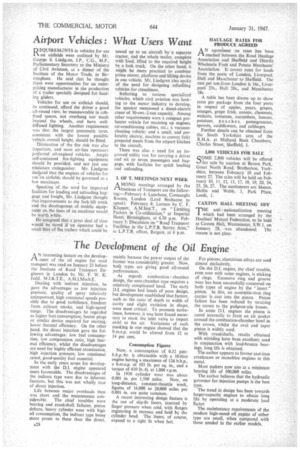The Dev e lopment of the Oil Engine A N interesting lecture on
Page 30

If you've noticed an error in this article please click here to report it so we can fix it.
the development of the oil engine for road transport was read on January 23 before the Institute of Road Transport Engineers in London by Mr. F. W. K. Judd. M.I.R.T.E., A.M.I.Mech.E.
Dealing with indirect injection, he gave the advantages as low injection presSare. quality of spray relatively unimportant, high rotational speeds possible due to good turbulence, freedom from exhaust smoke, and high-speed range. The disadvantages he regarded as higher fuel consumption, heater plugs or similar device required for starting, lower thermal efficiency. On the other hand, the direct injection gave the following advantages: low fuel consumption, low compression ratio, high thermal efficiency, whilst the disadvantages are need for highly efficient atomization. high injection pressure, low rotational speed, good-quality fuel essential.
In the early years scope for development with the D.I. engine appeared more favourable. The disadvantages of the indirect type were due to inherent features, but this was not wholly true of direct injection.
Life between major overhauls then was short and the maintenance con " siderable. The chief troubles were bearing and crankshaft failures, piston defects, heavy cylinder wear with high oil consumption, the indirect type being more prone to these than the direct, mainly because the power output of the former was considerably greater. Now, both types are giving good all-round performances.
As regards combustion chamber design, the ante-chamber type requires a relatively complicated head. The early D.I. engines had heads of poor design, hut development established that factors, such as the ratio of depth to width of cavity and slight variation in shape, were most critical. To promote turbulence, however, it was later found necessary to mask the inlet valve to impart swirl to the air: Variations of such masking in one engine showed that the b.m.e.p, could be altered from 12 to 14 per cent, Consumption Figures Now, a consumption of 0.32 pintb.h.p.-hr. is obtainable with a 10-litre engine having a maximum of 126 b.h.p.. a b.m.e.p. of 103 lb. per sq. in., and a torque of 410 lb.-ft, at 1,000 r.p.m.
In 1930 cylinder wear was about 0.001 in. per 1,500 miles. Now, on long-distance, constant-throttle work, figures of 16,000 to 20,000 miles per 0.001 in. are quite common.
A recent interesting design feature is the use of slip-fit liners, inserted by finger pressure when cold, with flanges registering in recesses and held by the cylinder head. The liners, of course, expand to a tight fit when hot. For pistons, aluminium alloys are used almost exclusively.
On the D.T. engine, the chief trouble, even now with some engines, is sticking of rings. Excessive ring and groove wear has been successfully countered on both types of engine by the " insert " piston. In this, an austenitic-iron ring carrier is, cast into the piston. Piston failure has been reduced by strutting the crown to the gudgeon-pin bosses.
In some D.I. engines the piston is cored internally to form an air pocket around the combustion-chamber bowl in the crown, whilst the oval and taper piston is widely used.
With crankshafts, results obtained with nitriding have been excellent; used in conjunction with lead-bronze bearings, long life is obtained.
The author appears to favour cast-iron crankcases or monobloc engines in this metal.
Most makers now aim at a minimum bearing life of 100,000 miles.
The author believes that the hydraulic governor for injection pumps is the best type.
The trend in design has been towards larger-capacity engines to obtain long life by operating at a moderate load factor The maintenance requirements of the modern high-soeed oil engine of either type are small, when compared with those needed in the earlier models.












































































